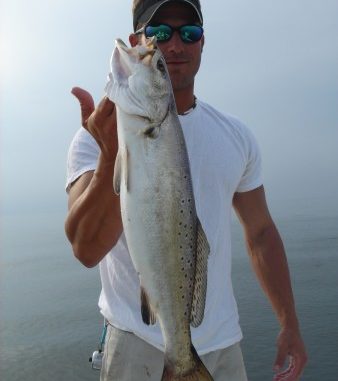
Captain Kerry Audibert with Ought To Be Fishing Charters (504-259-5304) hasn’t been catching a lot of limits lately, but it’s not because the fish aren’t biting. Rather, it’s because the fish he is catching are making his cooler overflow before he can finish. And Audibert has a pretty simple big fish formula that anybody can follow.
“One… fish Breton Sound,” he said. “Two… get yourself some live croakers. Put the two together and it equals big trout. Don’t even waste your time with shrimp. Carolina rig live croakers at any of your favorite structures in Breton Sound, and the trout will be there.”
As far as selecting which structures to fish, Audibert said the bottom line is that the farther out you go the bigger the trout you’ll catch. He’s been fishing a line of rigs that include Central, Main Pass Rigs and Free Mason. Anywhere in that whole line from north to south is where the big fish have been.
“That’s a big general area, but that whole stretch is where the bigger fish have been holding,” Audibert said. “And you’ve got to play the tide. Don’t waste your time going out there with a heavy, heavy tide range… anything 2 feet or better because the fish aren’t going to feed. If you can time it during the switch, the fish will feed during that slack time when it lays down.”
Audibert was adamant that the key to catching these big trout was to use as light a weight as possible to get your rig to the bottom. He’s had some instances lately during a slack tide when he was fishing in 25 to 30 feet of water and throwing a 1/8- or 1/4-ounce sinker.
“You want the bait to be as naturally presented to the fish as possible,” Audibert explained. “You want it to look like a croaker that’s just drifting along with the tide. If those fish are suspended in the water column, which 90 percent of the time they are… they’re not just laying with their nose in the mud on the bottom, you don’t want to throw out a 3/4-ounce weight just to get it to the bottom.”
If the trout are positioned in 30 feet of water but positioned about 16 feet down, Audibert explained that your rig would blow right past them before they even have a chance to figure out what it is you are offering to them.
“They’ll be looking down and saying, ‘Look, Jack, what was that that just went past,’” he quipped. “You want it to pass in front of their faces as slowly as you possibly can.”
This bite has been an extremely early bite, and Audibert has found that it’s pretty much over with by 8 or 9 in the morning. After this bite shuts off, Audibert has been chasing some of the smaller trout around the short rocks of the MRGO if he still has room in his cooler.
“The rocks have been very consistent all year,” Audibert concluded. “Sometimes people are slamming them, and sometimes they’re not. But you can always catch something at the rocks.
“All the structures in Eloi have also been good… the first cement rig, and Dead Man Island. The water is probably some of the cleanest water around. Black Bay has been dirty, but don’t let that fool you because there are fish there, too. And don’t be scared to throw live shrimp or croakers 4 feet under a cork on the edge of the rocks.”